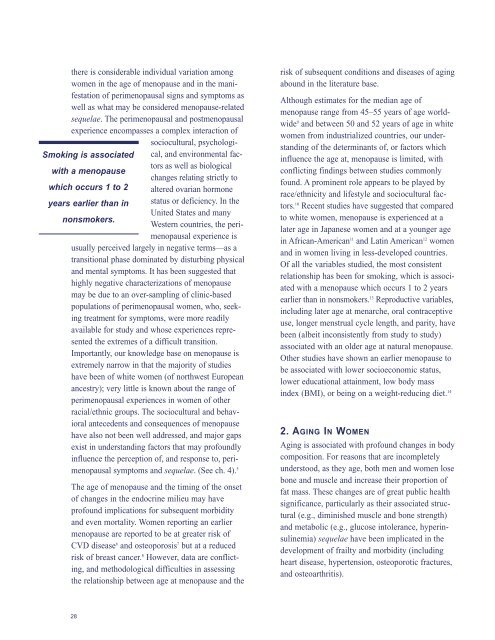WOMEN 'S HEALTH AND MENOPAUSE : - National Heart, Lung ...
WOMEN 'S HEALTH AND MENOPAUSE : - National Heart, Lung ...
WOMEN 'S HEALTH AND MENOPAUSE : - National Heart, Lung ...
You also want an ePaper? Increase the reach of your titles
YUMPU automatically turns print PDFs into web optimized ePapers that Google loves.
there is considerable individual variation among<br />
women in the age of menopause and in the manifestation<br />
of perimenopausal signs and symptoms as<br />
well as what may be considered menopause-related<br />
sequelae. The perimenopausal and postmenopausal<br />
experience encompasses a complex interaction of<br />
sociocultural, psychological,<br />
and environmental factors<br />
as well as biological<br />
changes relating strictly to<br />
altered ovarian hormone<br />
status or deficiency. In the<br />
United States and many<br />
Western countries, the perimenopausal<br />
experience is<br />
usually perceived largely in negative terms—as a<br />
transitional phase dominated by disturbing physical<br />
and mental symptoms. It has been suggested that<br />
highly negative characterizations of menopause<br />
may be due to an over-sampling of clinic-based<br />
populations of perimenopausal women, who, seeking<br />
treatment for symptoms, were more readily<br />
available for study and whose experiences represented<br />
the extremes of a difficult transition.<br />
Importantly, our knowledge base on menopause is<br />
extremely narrow in that the majority of studies<br />
have been of white women (of northwest European<br />
ancestry); very little is known about the range of<br />
perimenopausal experiences in women of other<br />
racial/ethnic groups. The sociocultural and behavioral<br />
antecedents and consequences of menopause<br />
have also not been well addressed, and major gaps<br />
exist in understanding factors that may profoundly<br />
influence the perception of, and response to, perimenopausal<br />
symptoms and sequelae. (See ch. 4). 5<br />
Smoking is associated<br />
with a menopause<br />
which occurs 1 to 2<br />
years earlier than in<br />
nonsmokers.<br />
The age of menopause and the timing of the onset<br />
of changes in the endocrine milieu may have<br />
profound implications for subsequent morbidity<br />
and even mortality. Women reporting an earlier<br />
menopause are reported to be at greater risk of<br />
CVD disease 6 and osteoporosis 7 but at a reduced<br />
risk of breast cancer. 8 However, data are conflicting,<br />
and methodological difficulties in assessing<br />
the relationship between age at menopause and the<br />
28<br />
risk of subsequent conditions and diseases of aging<br />
abound in the literature base.<br />
Although estimates for the median age of<br />
menopause range from 45–55 years of age worldwide<br />
9 and between 50 and 52 years of age in white<br />
women from industrialized countries, our understanding<br />
of the determinants of, or factors which<br />
influence the age at, menopause is limited, with<br />
conflicting findings between studies commonly<br />
found. A prominent role appears to be played by<br />
race/ethnicity and lifestyle and sociocultural factors.<br />
10 Recent studies have suggested that compared<br />
to white women, menopause is experienced at a<br />
later age in Japanese women and at a younger age<br />
in African-American 11 and Latin American 12 women<br />
and in women living in less-developed countries.<br />
Of all the variables studied, the most consistent<br />
relationship has been for smoking, which is associated<br />
with a menopause which occurs 1 to 2 years<br />
earlier than in nonsmokers. 13 Reproductive variables,<br />
including later age at menarche, oral contraceptive<br />
use, longer menstrual cycle length, and parity, have<br />
been (albeit inconsistently from study to study)<br />
associated with an older age at natural menopause.<br />
Other studies have shown an earlier menopause to<br />
be associated with lower socioeconomic status,<br />
lower educational attainment, low body mass<br />
index (BMI), or being on a weight-reducing diet. 14<br />
2. AGING IN <strong>WOMEN</strong><br />
Aging is associated with profound changes in body<br />
composition. For reasons that are incompletely<br />
understood, as they age, both men and women lose<br />
bone and muscle and increase their proportion of<br />
fat mass. These changes are of great public health<br />
significance, particularly as their associated structural<br />
(e.g., diminished muscle and bone strength)<br />
and metabolic (e.g., glucose intolerance, hyperinsulinemia)<br />
sequelae have been implicated in the<br />
development of frailty and morbidity (including<br />
heart disease, hypertension, osteoporotic fractures,<br />
and osteoarthritis).
















